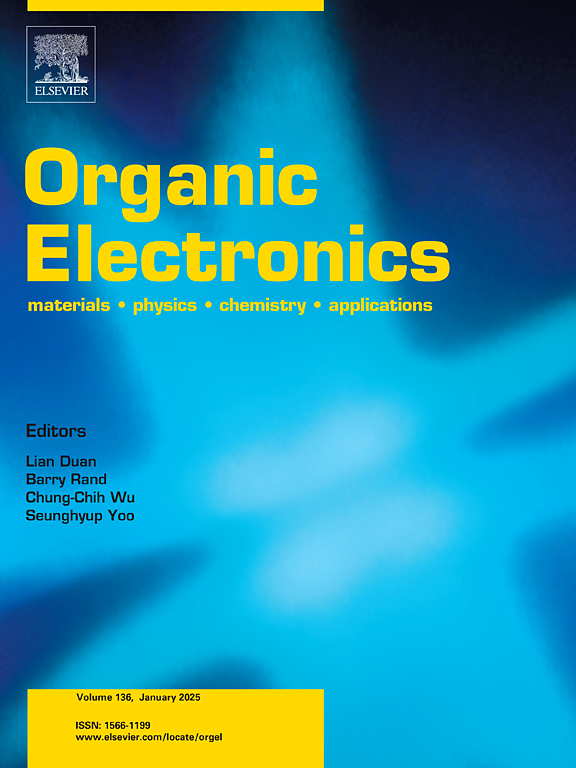基于TADF材料的超高效白光有机发光二极管集成了高效激复体
IF 2.7
4区 工程技术
Q3 MATERIALS SCIENCE, MULTIDISCIPLINARY
引用次数: 0
摘要
白色有机发光二极管(WOLED)是公认的健康光源。但是,设备的性能仍然受到主机或发射器的限制。本文开发了用于WOLEDs的多重激复体寄主,其中一种新型激复体寄主由热激活延迟荧光材料三嗪-卡唑(Trz-PhCz)和电子传输材料4,6-双[3,5-(二吡啶-4-基)苯基]-2-甲基嘧啶(B4PyMPM)组成,用于绿色、黄色、橙色和红色磷光掺杂剂,其外量子效率(EQEs)分别为25.0%、30.7%、32.5%和26.2%。另一方面,设计了一种由9,9′-联苯-3,3′-二基双- 9h -咔唑(mCBP)和B4PyMPM组成的高能激发物宿主,用于蓝色发射体铱(III)二(4,6-(二氟苯基)吡啶- n,C2′)吡啶酸(FIrpic),保证了最大EQE为26.3%。mCBP:B4PyMPM和Trz-PhCz:B4PyMPM宿主之间的激子能量差较小,可以促进宿主之间有效的能量传递。因此,在不使用任何光学外耦技术的情况下,这些激复体主机实现了最大EQE,功率效率和电流效率分别为36.9%,137.4 lm W−1和106.7 cd a−1的节能WOLEDs,这为未来高效oled的设计提供了灵感。本文章由计算机程序翻译,如有差异,请以英文原文为准。

Ultra-high-efficiency white organic light-emitting diodes based on TADF material incorporated efficient exciplex hosts
White organic light-emitting diode (WOLED) has been recognized as a healthy light source. However, the device performance is still limited by the hosts or emitters. Herein, multiple-exciplex hosts are developed for WOLEDs, in which a novel exciplex host consisting of a thermally activated delayed fluorescent material, triazine–carbazole (Trz-PhCz), and an electron-transport material, 4,6-bis[3,5-(dipyrid-4-yl)phenyl]-2-methylpyrimidine (B4PyMPM), is adopted for green, yellow, orange and red phosphorescent dopants, of which high external quantum efficiencies (EQEs) of 25.0 %, 30.7 %, 32.5 % and 26.2 %, respectively, are achieved. On the other hand, a high-energy exciplex host consisting of 9,9′-biphenyl-3,3′-diylbis-9H-carbazole (mCBP) and B4PyMPM is designed for the blue emitter, iridium(III)bis(4,6-(difluorophenyl)-pyridinato-N,C2’) picolinate (FIrpic), which guarantees a maximum EQE of 26.3 %. The small exciton energy difference between the mCBP:B4PyMPM and Trz-PhCz:B4PyMPM hosts can facilitate efficient energy transfer between the hosts. As a result, these exciplex hosts facilitate energy-efficient WOLEDs with a maximum EQE, power efficiency and current efficiency of 36.9 %, 137.4 lm W−1 and 106.7 cd A−1, respectively, without using any optical out-coupling techniques, which provides inspiration for the future design of efficient OLEDs.
求助全文
通过发布文献求助,成功后即可免费获取论文全文。
去求助
来源期刊

Organic Electronics
工程技术-材料科学:综合
CiteScore
6.60
自引率
6.20%
发文量
238
审稿时长
44 days
期刊介绍:
Organic Electronics is a journal whose primary interdisciplinary focus is on materials and phenomena related to organic devices such as light emitting diodes, thin film transistors, photovoltaic cells, sensors, memories, etc.
Papers suitable for publication in this journal cover such topics as photoconductive and electronic properties of organic materials, thin film structures and characterization in the context of organic devices, charge and exciton transport, organic electronic and optoelectronic devices.
 求助内容:
求助内容: 应助结果提醒方式:
应助结果提醒方式:


